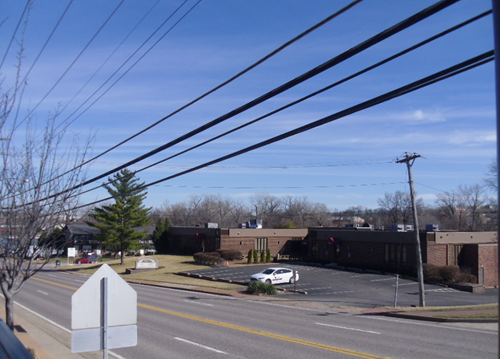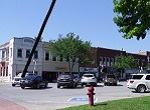Are Ugly Utility Lines Really a Big Deal?
There are very few things that I've changed my mind about completely during the course of my career as an urban planner and community development professional. However, I have done a complete 180 degree turn on the topic of whether addressing ugly utility lines are a priority issue for business districts or even whole neighborhoods or towns. I now think your money and energy probably should be invested in other projects.
Here's the rationale. While ugly utility lines can ruin a highly scenic view, few of you are actually wrestling with great scenery. If you are, then yes, if you have the money, you could bury those lines.
If a district or neighborhood does not have outstanding scenic beauty throughout, think carefully about both the cost of underground burial and the tremendous disruption this will bring in the short run as the project is taking place. Sometimes business districts take several years to recover their former level of thriving, although of course this varies with the type of businesses you have and the amount of competition they experience if you are in a metropolitan area. If the only dry cleaner or veterinarian in the whole town is within the project area, customers will do what it takes to visit those businesses and continue to do so. However, if you have restaurants in a metro where there are abundant bistros and cafes nearby, customers may not return unless you have a true destination restaurant.
For residential districts, it's an entirely different calculation, but yet the cost and disruption, versus the benefits, should be weighed.
Next I'll give you some questions to help you evaluate what to do. The page winds up with some photos for you to contemplate.
Nine Questions to Ask About Whether You Want to Replace Ugly Utility Lines
1. Do we have enough street life and vibrant activity that visitors and neighbors alike are probably distracted from those utility poles and lines?
2. Is there a compelling scenic reason that we should bury the lines?
3. How much damage will the probably lengthy construction process cause to our loyal customers or residents?
4. Is the frequent disruption of service, both from electrical and cable companies, a factor in our motivation and decision making? Should it be?
5. Are overhead lines common, or in fact the norm, in the surrounding area? (If so, it may be less important to place the lines underground; people do grow accustomed to the current situation.)
6. Can the burial process be combined with other essential infrastructure work, such as installation of fiber optics or replacement of water and sewer lines? If so, the cost factor may be partially cancelled out.
7. Will other underground utilities need to be relocated, either permanently or temporarily during construction, to accommodate the buildout?
8. Do your utility companies using the poles have any programs to help subsidize burial?
9. Regardless of the local arguments for and against any proposal to replace ugly utility lines, how do the property owners, business owners and managers, and residents feel about the proposal? Stepping back in the face of furor can be a good move, maybe even just as smart as considering the utility line question in the first place.
Some Examples of Ugly Utility Lines for Discussion
1. These major lines lie in a park near a parking area, popular pavilion, and a trail.

2. Here is a common use in a business district that also is near apartments set back from the street. This area does have some foot traffic, especially to the left of the photo.

3. Here the commercial environment is somewhat different. This instance shows a low-rise office building near fast food and other businesses along a major suburban thoroughfare.

4. Next, what do you think about these overhead lines in front of an historic theater now being preserved?

5. What about aerial lines in front of a popular restaurant near a riverfront, in an area with a decent amount of tourist traffic?

In these examples, I steered away from places of obvious great scenic beauty. However, one complicating factor for such places is that underground burial on a mountain would present obvious and formidable obstacles you probably would want to avoid, while you will find that the closer the power line is to a river or lake, the more likely the lines will be overhead to minimize environmental damage.
Nonetheless, discussing these examples with your neighborhood may help clarify the issues for you.
These Pages May Be Of Interest Too
- Community Development >
- Community Beautification > Ugly Utility Lines
Join GOOD COMMUNITY PLUS, which provides you monthly with short features or tips about timely topics for neighborhoods, towns and cities, community organizations, and rural or small town environments. Unsubscribe any time. Give it a try.




